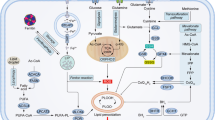Abstract
We have previously found toxic effects of iron chelate, Fe-NTA on cultured normal rat liver epithelial cells (RL34). In the present study, when RL34 cells were exposed to 50 μg/ml iron of Fe-NTA for 15 days, besides the expected cytolytic effects in most cells, the appearance of resistant cells was observed. The resistant cells showed drastic morphological transformation, grew in soft agar, and induced hepatocellular carcinomas when transplanted into syngeneic newborn rats in a short period of time. Since DNA instability in the transformed cells was ascertained by differential AO staining, it is suggested that DNA damage by Fe-NTA is of a critical importance for extremely rapid neoplastic transformation of normal epithelial cells.
Similar content being viewed by others
Abbreviations
- AO:
-
acridine orange
- DME medium:
-
Dulbecco's modified Eagle's medium
- FCS:
-
fetal calf serum
- Fe-HEDTA:
-
ferric-N-(2-hydroxyethyl)ethylenediaminetriacetic acid
- Fe-NTA:
-
ferric-nitrilotriacetate
- HEPES:
-
N-2-hydroxyethylpiperazine-N′-2-ethanesulfonic acid
- PBS:
-
Dulbecco's phosphate-buffered saline
References
Awai M, Narasaki M, Yamanoi Y and Seno S (1979) Induction of diabetes in animals by parenteral administration of ferric nitrilotriacetate: A model of experimental hemochromatosis. Am. J. Pathol. 95: 663–674.
Borek C, Ong A, Mason H, Donahue L and Biaglow JE (1986) Selenium and vitamin E inhibit radiogenic and chemically induced transformation in vitro via different mechanisms. Proc. Natl. Acad. Sci. USA 83: 1490–1494.
Ebina Y, Okada S, Hamazaki S, Ogino F, Li L and Midorikawa O (1986) Nephrotoxicity and renal cell carcinoma after use of iron- and aluminum- nitrilotriacetate complexes in rats. J. Natl. Cancer Inst. 76: 107–113.
Fukuda M, Miyoshi N, Hattori T, Sugihara H, Hosokawa Y and Nakanishi K (1986) Different instability of nuclear DNA at acid hydrolysis in cancerous and noncancerous cells as revealed by fluorescent staining with acridine orange. Histochemistry 84: 556–560.
Halliwell B and Gutteridge JMC (1986) Oxygen free radicals and iron in relation to biology and medicine: some problems and concepts. Arch. Biochem. Biophys. 246: 501–514.
Hamazaki S, Okada S, Ebina Y and Midorikawa O (1985) Acute renal failure and glucosuria induced by ferric nitrilotriacetate in rats. Toxicol. Appl. Pharmacol. 77: 267–274.
Inoue S and Kawanishi S (1987) Hydroxyl radical production and human DNA damage induced by ferric nitrilotriacetate and hydrogen peroxide. Cancer Res. 47: 6522–6527.
Jacobs A, Hoy T, Humphrys J and Perera P (1978) Iron overload in Chang cell cultures: Biochemical and morphological studies. Brit. J. Exp. Pathol. 59: 489–498.
Johnson PJ, Krasner N, Portmann B, Eddleston ALW and Williams R (1978) Hepatocellular carcinoma in Great Britain: influence of age, sex, HBsAg status, and aetiology of underlying cirrhosis. Gut 19: 1022–1026.
Karasaki S and Okigaki T (1976) Surface membrane nucleoside triphosphatase activity and tumorigenicity of cultured liver epithelial cells. Cancer Res. 36: 4491–4499.
Kennedy AR, Troll W and Little JB (1984) Role of free radicals in the initiation and promotion of radiation transformation in vitro. Carcinogenesis 5: 1213–1218.
McLaren GD, Muir WA and Kellermeyer RW (1984) Iron overload disorders: natural history, pathogenesis, diagnosis, and therapy. CRC Crit. Rev. Clin. Lab. Sci. 19: 205266.
Nakamoto S, Yamanoi Y, Kawabata T, Sadahira Y, Mori M and Awai M (1986) Lipid peroxidation and cytotoxicity of Ehrlich ascites tumor cell by ferric nitrilotriacetate. Biochim. Biophys. Acta 889: 15–22.
Okada S, Hamazaki S, Ebina Y, Fujioka M and Midorikawa O (1983) Nephrotoxicity and induction of the renal adenocarcinoma by ferric-nitrilotriacetate (Fe-NTA) in rats. In: Urushizaki I, Aisen P, Listowsky I and Drysdale JW (eds.) Function of Iron Storage and Transport Proteins (pp. 473–478). Elsevier, New York.
Okada S, Hamazaki S, Ebina Y, Li L and Midorikawa O (1987) Nephrotoxicity and its prevention by vitamin E in ferric nitrilotriacetate-promoted lipid peroxidation. Biochim. Biophys. Acta 922: 28–33.
Okigaki T (1977) A reproducible technique of rat liver culture. Tissue Culture Assoc. Man. 3: 565–566.
Okigaki T, Davis M and Quan SG (1976) Preliminary notes on liver epithelial cell transformation with chemical carcinogens. Proc. Jpn. Acad. 52: 312–315.
Patterson MKJr (1979) Measurement of growth and viability of cells in culture. In: Jakoby WB and Pastan IH (eds.) Methods in Enzymology (pp. 141–152) Academic Press, New York.
Saito M, Tanaka N, Ohkawa Y and Inui N (1987) Inhibition of 12-O-tetradecanoylphorbol-13-acetate-enhanced transformation in vitro by radical scavengers. Cancer Lett. 35: 167–171.
Yamada M, Okigaki T and Awai M (1987a) Adhesion and growth of rat liver epithelial cells on an extracellular matrix with proteins from fibroblast conditioned medium. Cell Struct. Funct. 12: 53–62.
Yamada M, Okigaki T and Awai M (1987b) Role of superoxide radicals in cytotoxic effects of Fe-NTA on cultured normal liver epithelial cells. Cell Struct. Funct. 12: 407–420.
Yamanoi Y, Matsuura R and Awai M (1982) Mechanism of iron toxicity in the liver and pancreas after a single injection of ferric nitrilotriacetate. Acta Haematol. Jpn. 45: 1229–1235.
Zimmerman R and Cerutti P (1984) Active oxygen acts as a promoter of transformation in mouse embryo C3H/10T1/2/C18 fibroblasts. Proc. Natl. Acad. Sci. USA 81: 2085–2087.
Author information
Authors and Affiliations
Rights and permissions
About this article
Cite this article
Yamada, M., Awai, M. & Okigaki, T. Rapid in vitro transformation system for liver epithelial cells by iron chelate, Fe-NTA. Cytotechnology 3, 149–156 (1990). https://doi.org/10.1007/BF00143677
Received:
Issue Date:
DOI: https://doi.org/10.1007/BF00143677




